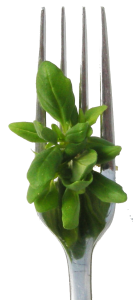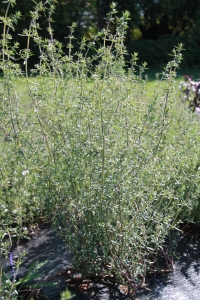 One of the perks of writing the product descriptions for Blue Moon’s weekly newsletters is getting to sample those products. This was especially true last week, when I had the pleasure to try the season’s first offering of Summer Savory. I was struck by the thymey, oreganoy flavor; the mild numbing effect it had on my tongue and lips. How had I made it 38 years without once experiencing this gem of an herb?
One of the perks of writing the product descriptions for Blue Moon’s weekly newsletters is getting to sample those products. This was especially true last week, when I had the pleasure to try the season’s first offering of Summer Savory. I was struck by the thymey, oreganoy flavor; the mild numbing effect it had on my tongue and lips. How had I made it 38 years without once experiencing this gem of an herb?
Summer savory (Satureja hortensis) has a long, storied history. Native to southeastern Europe and the Mediterranean regions, it was singled out by Virgil for its fragrance. One of America’s earliest settlers, John Josselyn also valued the herb, including it in a list of plants introduced in the new world, to help recent migrants remember their native gardens. Even Shakespeare, in The Winter’s Tale, writes about it:
Here’s flowers for you;
Hot Lavender, mints, savoury,
Marjoram;
The marigold that goes to bed
Wi’ the sun
And with him rises weeping:
these are flowers
of middle summer, and I think
they are given
to men of middle age
Summer savory is also famous for its medicinal applications. First used by the Egyptians as an additive to their famous love potions, it has also been used to treat bee and wasp-stings, intestinal disorders, palsy, sciatica, sore throats, and dim vision. Famous seventeenth century apothecary Nicholas Culpepper touted Savory as a panacea, recommending some always be kept on hand:
“…the Summer kind is the best… It expels tough phlegm form the chest and lungs, quickens the dull spirits in the lethargy… dropped into the eyes it clears them of thin cold humors proceeding from the brain….”
These days, Summer Savory is mainly used in the kitchen. It figures prominently in Bulgarian cuisine, where it is known as chubrista. Bulgarians keep savory, along with salt and paprika, on their dining room tables, the same way Americans keep salt and pepper. These three herbs are often mixed together to make something called sharena sol, or colorful salt.
In the Atlantic Canada region, summer savory is used as sage is used elsewhere—in dressing for fowl, mixed with ground pork, or eaten with turkey, goose, and duck.
And if you’ve ever wondered what makes Herb de Provence so zesty: yep, summer savory.
 Food writer Marie Viljoen blogs about the myriad ways to use the herb:
Food writer Marie Viljoen blogs about the myriad ways to use the herb:
“I chop a whole cup of fresh savory leaves… and a cup of chopped flat-leaf parsley and a crushed clove of garlic, and cook both very gently in four tablespoons of butter. After five minutes, add a squeeze of lemon juice, cook another minute or so for it to caramelize, and pour over grilled mushroom just before eating.”
Any way you slice it (or dry it or mince it) Summer Savory is one of the most understated, unappreciated herbs under the sun. It’s high time you savored the savory.
